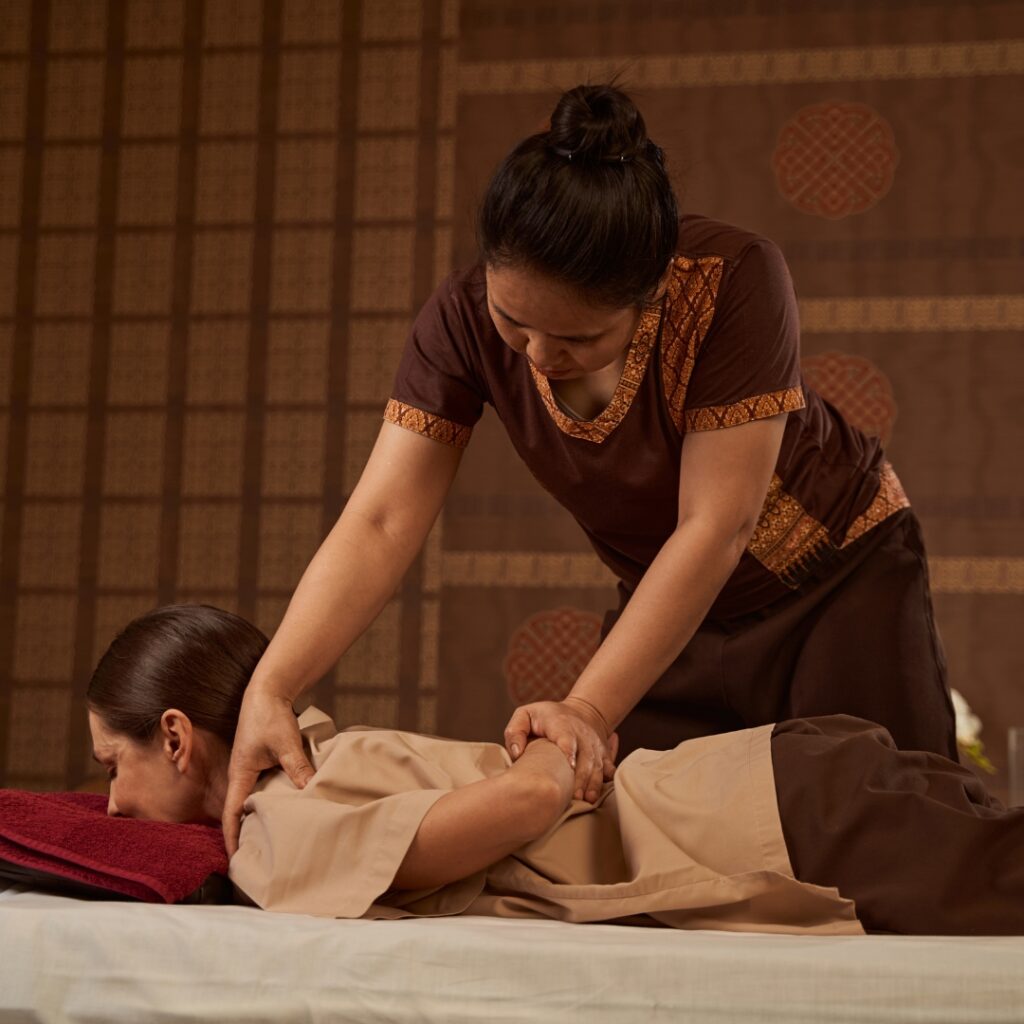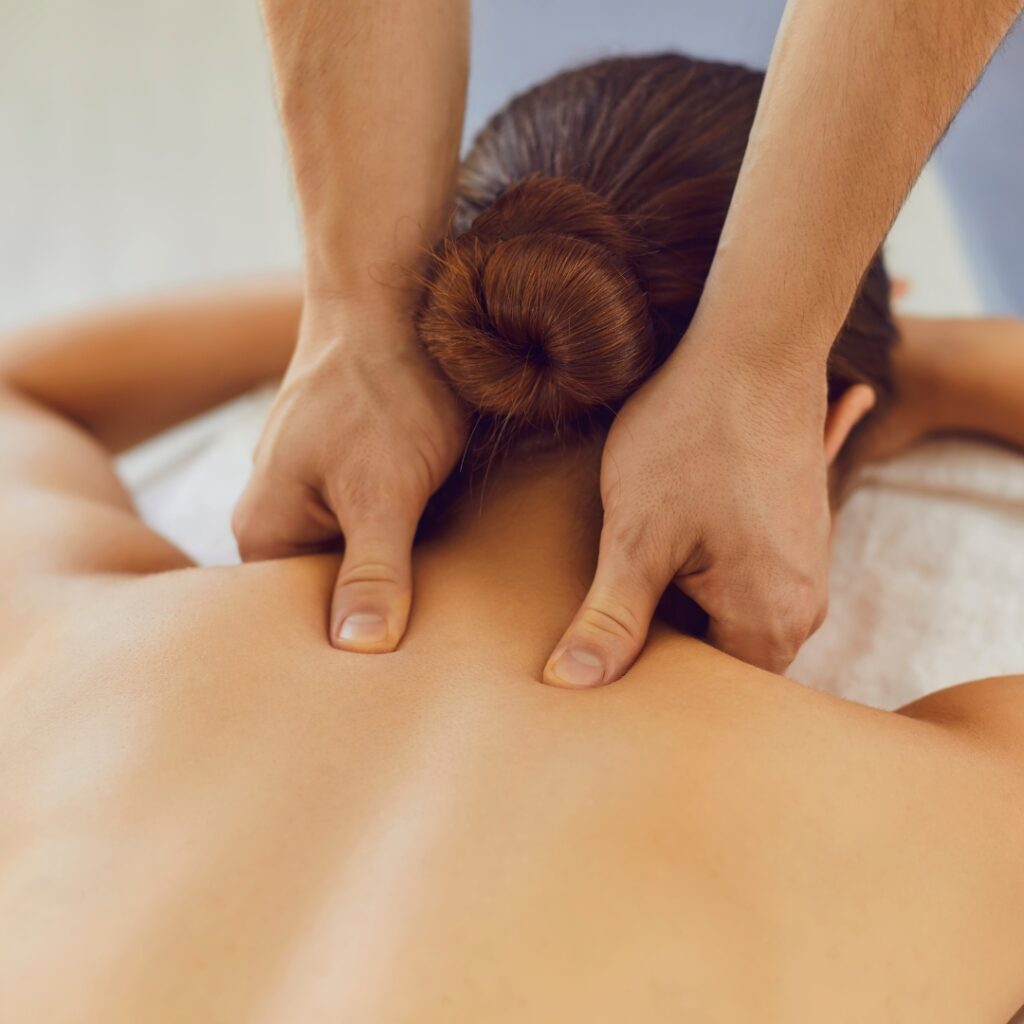Thai massage is a traditional healing practice that combines acupressure, assisted yoga stretches, and deep tissue massage. Integrating Thai massage techniques into your daily routine can enhance flexibility, reduce stress, improve circulation, and promote overall well-being. Here’s how you can incorporate these techniques into your everyday life:
1. Start with Simple Stretching
- Gentle Morning Stretches: Begin your day with simple Thai-inspired stretches to wake up your body. Focus on movements that stretch the muscles while improving flexibility. Try seated forward bends, hamstring stretches, and gentle spinal twists to loosen up your body.
- Example: Sit on the floor with your legs extended. Slowly lean forward, reaching for your toes. Hold for 20-30 seconds, breathing deeply.
2. Incorporate Acupressure Points
- Target Pressure Points: Thai massage uses pressure on specific points along the body’s energy lines (Sen lines). You can use acupressure on key areas like the shoulders, neck, hands, and feet. Gently pressing these points can relieve tension, improve circulation, and balance your energy.
- Example: Use your thumb to apply pressure to the middle of your palms or the center of your feet. Hold for about 15-20 seconds on each spot for relief from fatigue or stress.

3. Practice Assisted Yoga Stretches
- Incorporate Passive Stretches: Thai massage often involves assisted stretches where your therapist helps to gently stretch your body. You can replicate this by using a partner or wall for support. Regular stretching can improve flexibility, joint mobility, and muscle relaxation.
- Example: Stand tall and reach both arms overhead. Gently stretch to each side, holding for 10-15 seconds to release tightness in your back and sides.
4. Use Thai Massage Techniques on Your Feet
- Foot Reflexology: Thai massage often includes foot massage, which targets specific reflex points that correspond to different parts of the body. You can integrate foot reflexology into your routine by using a tennis ball, foot roller, or even your hands to massage the soles of your feet.
- Example: Sit comfortably and roll a tennis ball under your feet, moving from the arch to the heel. This promotes relaxation and reduces stress.
5. Breathing and Relaxation
- Focus on Deep Breathing: Thai massage incorporates deep, mindful breathing to help clients relax during stretches. Practicing deep belly breathing can reduce stress, lower blood pressure, and improve oxygen flow throughout your body.
- Example: Practice deep diaphragmatic breathing—breathe in deeply through your nose, allowing your belly to expand, then exhale slowly through your mouth. Repeat for several minutes.
6. Incorporate Thai Massage Movements with a Foam Roller
- Self-Massage Techniques: Foam rolling can mimic some Thai massage movements like deep tissue compression. It’s a great tool to release muscle tension in your back, thighs, and calves.
- Example: Use the foam roller on your thighs, calves, and upper back for 2-3 minutes per area. Focus on areas of tension and roll slowly to massage out tightness.
7. Use Thai Herbal Compresses (Optional)
- Therapeutic Heat: Thai herbal compresses are used in Thai massage to relieve muscle tension. You can use a warm compress at home with herbs like lemongrass, ginger, and turmeric to soothe sore muscles and joints.
- Example: Heat a herbal compress or use a warm towel infused with essential oils. Apply it to sore muscles or joints for 10-15 minutes to promote healing and relaxation.
8. Incorporate Thai Massage Into Your Self-Care Routine
- Create a Daily Ritual: Integrate Thai massage techniques into a calming routine. After a busy day, use techniques like stretching, acupressure, or foam rolling to unwind and relax.
- Example: Set aside 10-15 minutes each evening for a Thai-inspired stretch session. Include foot massage, gentle yoga poses, and breathing exercises.

9. Practice Mindfulness and Presence
- Mind-Body Connection: Thai massage emphasizes the importance of being present in the moment. Apply this mindfulness during your self-care routine, whether it’s during stretches, massage, or breathing exercises. This mental relaxation complements the physical benefits of Thai massage.
- Example: As you perform your daily stretches, focus on how your body feels during each movement. Stay present and listen to your body’s needs.
10. Commit to Consistency
- Make It a Daily Habit: The key to benefiting from Thai massage techniques is consistency. Regular practice will improve flexibility, reduce muscle tightness, and help prevent stress-related tension. Set aside time each day to incorporate these techniques into your routine.
- Example: Start by committing to 10 minutes of Thai-inspired stretching and self-massage each day. Gradually increase the time as you become more comfortable.
Conclusion
Integrating Thai massage techniques into your daily routine doesn’t require a lot of time or complicated tools. By incorporating simple stretches, acupressure, self-massage, and breathing exercises, you can experience the physical and mental benefits of Thai massage every day. These practices can help reduce stress, improve flexibility, and enhance overall well-being, making Thai massage a valuable addition to any self-care routine.

